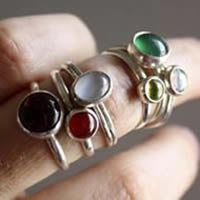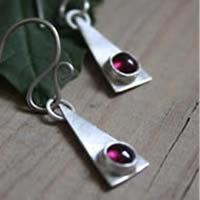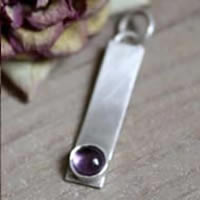- Jewelry
- Inspiration
- Good Deals
- Paintings
- About
- Contact
JEWELRY
- Anklet
- Bracelets
- Brooches
- Cufflinks
- Earrings
- Pendants & Necklaces
- Rings
- Draw your jewelry
- GOOD DEALS
- How to clean your jewel
- Metal we used
INSPIRATION
- Our imagination
- Birthstones
- Druids and druidesses
- Flower meanings
- History, archeology jewelry
- Japanese symbols
- Lithotherapy and stone choice
- Illumination jewelry
- Maya calendar jewelry
- Stone color symbolism
- Stones Catalogue
- Searches a theme on the site
ABOUT
Garnet: history, healing properties and lithotherapy
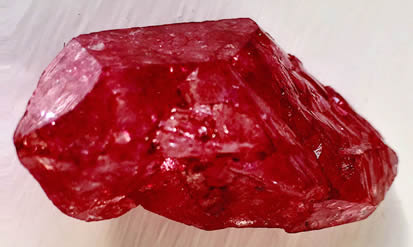
Garnet properties

The garnet, an emblematic stone of the silicates, forms a family of crystalline minerals distinguished by a range of vibrant hues, often associated with a deep, intense red.
The name "garnet" derives from the Latin "granatus," meaning "grain-shaped," likely referring to its similarities in shape, size, and color to the seeds of a pomegranate.
This mineral exists in various varieties, offering a rich palette of colors, with the exception of blue. Thus, shades of brown, red, green, yellow, black, and colorless can be found, each possessing a specific name and unique properties:
- Pyrope: With a fiery red hue that leans slightly toward brown, pyrope is renowned for its vitreous luster and translucency, often used in jewelry for its vibrant and enduring color.
- Rhodolite: This garnet stands out with its pinkish-red hue that has violet undertones, bringing a touch of softness and romance, highly valued in jewelry for its refined color.
- Almandine: Brick red in color, sometimes leaning toward violet, almandine is often associated with strength and vitality; its darker shade gives it a deep and mysterious character.
- Spessartine: Ranging from bright orange to reddish-brown, spessartine is a dynamic stone reminiscent of autumn hues, associated with creativity and energy.
- Hessonite: With its distinctive dark orange color, it is nicknamed "cinnamon stone" due to its warm hue and is appreciated for its warm and vibrant luster.
- Tsavorite: With its intense green color, tsavorite is one of the most precious varieties of garnet, sometimes rivaling emerald for its rich hue and rarity.
- Demantoid: Its green shades ranging from prairie to emerald give it a unique and brilliant appearance, sought after for its rarity and high light dispersion, creating an intense inner "fire."
Garnets belong to the cubic crystal system, giving them distinctive symmetry and often remarkable luster. These stones have a hardness ranging from 6.5 to 7.5 on the Mohs scale, making them relatively durable and ideal for jewelry. Additionally, garnets are known for their high refractive index, which gives them a special brilliance and makes them highly sought after by collectors.
Stories, legends and beliefs about the garnet
Garnet holds a prominent place in the history of gemstones, not only due to its relative abundance compared to sapphire or ruby but also because of its versatility. This stone, known for its hardness and durability, has been a valuable tool for engraving other stones, such as agates and jaspers, since ancient times. Ground into abrasive powder, it was used to polish and shape these same materials, a practice that continues today in modern applications, including precision cutting by water jet and adhesion on sandpaper.
As early as the Bronze Age, garnet was mined, particularly in the region that is now the Czech Republic, where the main pyrope garnet mine already fueled local trade and uses. The garnet jewelry found in this area attests to advanced craftsmanship, and Czech garnet is still renowned today for its exceptional quality.
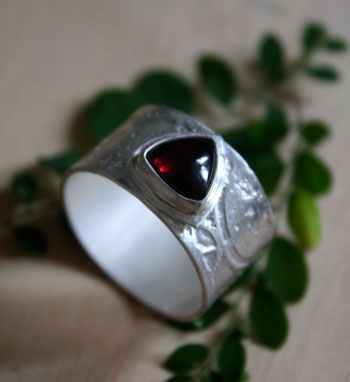
Garnet has a rich and diverse historical heritage, tracing back to the civilizations of ancient Egypt, where red garnet was commonly used in the adornments of pharaohs. This gemstone often accompanied these rulers into their tombs to serve as a talisman in the afterlife and was dedicated to Sekhmet, the lion-headed goddess of war adorned with a solar disk. In Egypt, this stone symbolized power, protection, and rebirth.
In ancient Mesopotamia, the Sumerians, as early as 2100 BC, used garnet to engrave and decorate the stones used in their ornaments and ritual objects.
In Scandinavia, archaeological discoveries dating from 2000 to 1000 BC reveal that garnet was utilized in the royal and warrior adornments of the Nordic peoples.
References to garnet abound in ancient texts: the Greek philosopher Theophrastus (372-287 BC) referred to this stone as "anthrax" or "coal," believing it could illuminate the darkness with its power of night vision, while Pliny the Elder, a Roman writer and naturalist, described it as "almandin carbunculus," or "burning coal," in reference to its deep red luster.
The Celts, for their part, incorporated garnet into their jewelry and weapons due to its symbolism of courage and protection, enhanced by properties perceived as magical.
In the Hebrew Talmud, it is narrated that Noah's Ark found its light through a massive garnet, named Bareketh, meaning "shimmering stone," or Barak, which evokes lightning.
In the Bible, garnet is also mentioned among the ornamental stones of Aaron's breastplate, signifying divine protection.
During the Middle Ages, garnet was revered for its spiritual virtues. It was reputed to strengthen faith and dispel melancholy, in addition to being considered a valuable remedy against inflammation and epidemics. Crusaders often wore garnets to find strength and courage in their battles, viewing it also as a protective talisman against diseases.
Among Arab rulers, garnet symbolized sincerity and truth. It is also mentioned in the Quran, in a fourth heaven made of carbuncles—a likely reference to garnet.
The Native American tribes of North and Central America, notably the Aztecs and the Mayans, regarded garnet as a sacred stone. Northern peoples used it in jewelry, as well as to decorate shields and dreamcatchers, seeing it as possessing spiritual revelation and protection against negative energies.
Garnet, closely associated with the image of blood due to its dominant hue, holds a particular symbolism in many traditions. Among Asian tribes, this blood association granted it protective properties against wounds. During the Hanza rebellion against British troops in 1892 near the Kashmir border, garnets were even used as projectiles, reinforcing the symbolic and defensive power of this stone.
In India and the Far East, garnet is valued as a protective amulet against poisons and epidemics, while also being associated with health and the joy of living. This duality, as both a formidable weapon and a benevolent talisman, highlights the depth of beliefs attached to this stone across cultures and epochs.

In addition to its reputed protective qualities, garnet also carries deep symbols and promises of prosperity. According to popular beliefs, this precious stone is known for its protective power against wounds and poison, its ability to stop bleeding, as well as its symbolism of truth and fidelity.
Beyond its symbolic properties, garnet is also closely associated with January birthdays, making it a favored birthstone for centuries. This enduring tradition has made it a semi-precious stone cherished by jewelers, who enhance it in inspiring creations, celebrating birth and promising prosperity and happiness to those who wear this precious gem.
Mines: Italy, Brazil, Tanzania, the USA, and Sri Lanka.
Healing properties and benefits of the garnet
Garnet is perceived not only as a stone of vitality but also as a symbol of courage and passion in the realm of lithotherapy. Its reputation as the "stone of health" is based on physical, emotional, and spiritual virtues that transcend mere physical benefits.
- In addition to regenerating skin cells, garnet is said to act as a protective shield against free radicals, which are responsible for premature aging. It is also believed to promote collagen production, helping to maintain skin elasticity and firmness. Garnet, particularly the red and orange varieties, is highly regarded for its effects on bone health. In addition to alleviating joint and muscle pain, it may strengthen bone density and aid in calcium reabsorption in the body, contributing to the solidity of bones.
- It is said to promote healing and limit bleeding by stimulating blood coagulation. This precious stone is also believed to regulate the thyroid and stimulate the heart while soothing inflammation, anemia, and circulatory issues.
- Due to its connection with the sacral chakra, garnet is thought to stimulate sexual energy in a balanced way, fostering a better understanding of oneself in this area. It could serve as support in managing the emotional energies associated with intimacy, contributing to a better harmony between desire and emotional fulfillment.
- Associated with blood purification, garnet is reputed to detoxify the organs, particularly the liver and kidneys. It is believed to enhance the elimination of accumulated toxins, thereby strengthening the body's natural defenses and facilitating the absorption of essential nutrients.
- In lithotherapy, garnet is often linked to emotional stability. Worn as a talisman, it is thought to help dissipate negative feelings such as fear and anger. Its vibration allows individuals to stay grounded, fostering a deep connection to reality and helping them overcome challenges with strength and resilience.
- As a stone of the root chakra, garnet is also known to revive motivation and determination. It encourages the creative spirit to explore new ideas and pushes one to transform dreams into tangible actions, thus stimulating the will for personal achievement.
⚠ Please note that all healing properties presented for gemstones are gathered from various sources. This information is provided as a service and is not intended to treat medical conditions. It is recommended to consult a healthcare professional for serious medical issues and not to rely solely on gemstones as a treatment.












